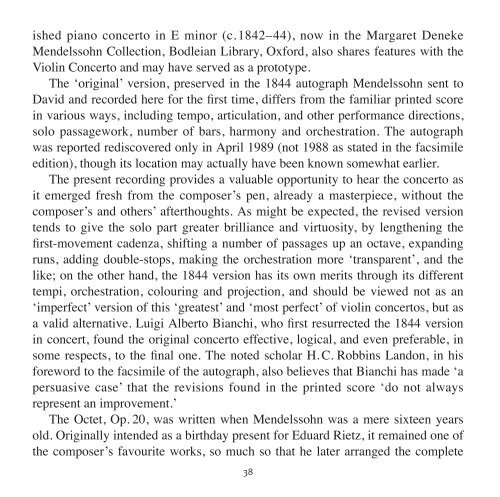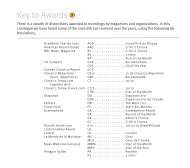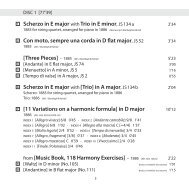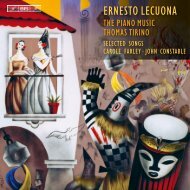MENDELSSOHN - Bis
MENDELSSOHN - Bis
MENDELSSOHN - Bis
Create successful ePaper yourself
Turn your PDF publications into a flip-book with our unique Google optimized e-Paper software.
ished piano con certo in E minor (c.1842–44), now in the Mar garet Deneke<br />
Mendelssohn Collection, Bodleian Lib rary, Ox ford, also shares features with the<br />
Violin Con certo and may have served as a proto type.<br />
The ‘original’ version, preserved in the 1844 autograph Mendelssohn sent to<br />
David and recorded here for the first time, differs from the familiar print ed score<br />
in various ways, including tempo, articulation, and other per formance directions,<br />
solo passagework, number of bars, harmony and orch estra tion. The autograph<br />
was re ported rediscovered only in April 1989 (not 1988 as stated in the fac simile<br />
edition), though its location may actually have been known some what earlier.<br />
The present recording provides a valuable op por tunity to hear the concerto as<br />
it emerged fresh from the composer’s pen, already a masterpiece, without the<br />
com poser’s and others’ afterthoughts. As might be expected, the revised version<br />
tends to give the solo part greater brilliance and virtuosity, by lengthening the<br />
first-move ment cadenza, shifting a number of pas sages up an octave, expanding<br />
runs, adding double-stops, making the orchestration more ‘transparent’, and the<br />
like; on the other hand, the 1844 version has its own merits through its differ ent<br />
tempi, orch estra tion, col our ing and projection, and should be viewed not as an<br />
‘imperfect’ version of this ‘great est’ and ‘most perfect’ of violin con cer tos, but as<br />
a valid al ter native. Luigi Alberto Bianchi, who first resurrected the 1844 version<br />
in con cert, found the original concerto effective, log ical, and even preferable, in<br />
some respects, to the final one. The noted scholar H. C. Robbins Landon, in his<br />
fore word to the facsimile of the auto graph, also believes that Bianchi has made ‘a<br />
persuasive case’ that the revi sions found in the printed score ‘do not always<br />
represent an improvement.’<br />
The Octet, Op. 20, was written when Mendelssohn was a mere sixteen years<br />
old. Originally intended as a birthday present for Eduard Rietz, it remained one of<br />
the composer’s favourite works, so much so that he later arranged the complete<br />
38








